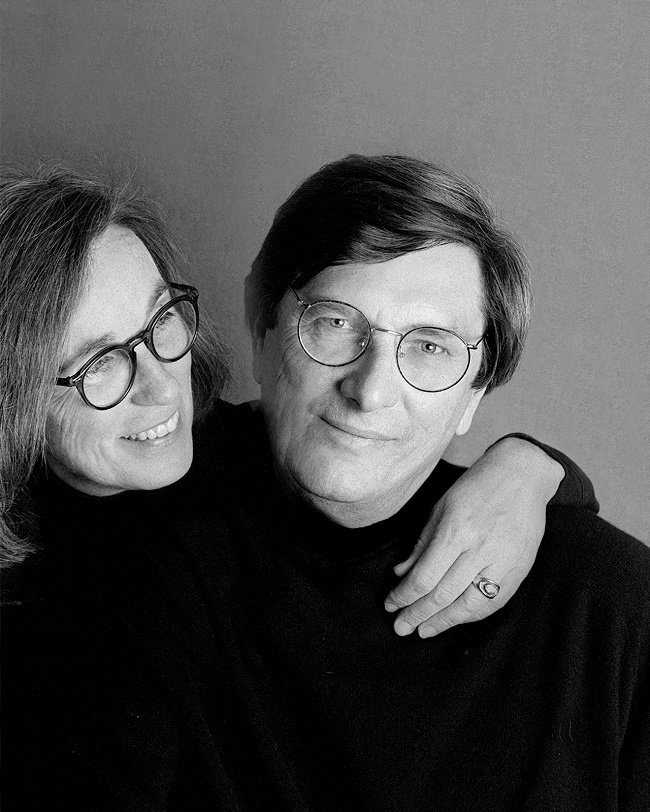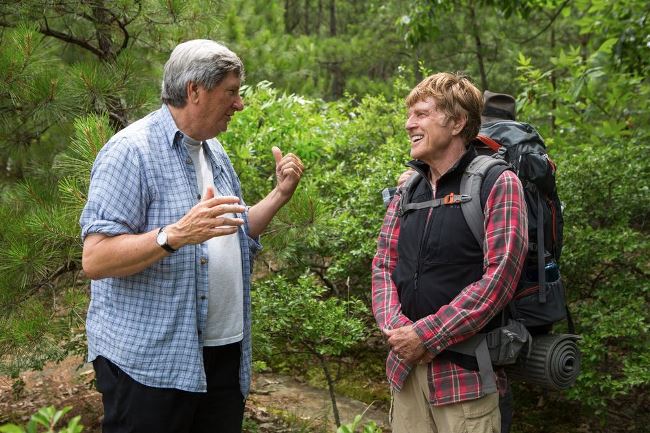
A Walk in the Woods, the Ken Kwapis-directed feature that premieres today at the Sundance Film Festival, is an adaption of a memoir written by Bill Bryson about his experiences hiking on the Appalachian Trail.
For two decades, the beloved American author wrote books about his travel adventures around the world while working as a journalist in England. After returning to his homeland in 2003, he hiked on the trail with a boyhood friend named Katz.
The independent feature attracted an array of talented filmmakers. Oscar-winning actor, director, and producer Robert Redford, who played a pivotal role in producing the film, portrays Bryson. Meanwhile, screenwriter Michael Arndt, who earned an Academy Award for Little Miss Sunshine in 2007 and another nomination in 2011 for Toy Story 3, penned the adaptation. The rest of the cast for A Walk in the Woods includes Nick Nolte (as Katz) and Emma Thompson.
Director Kwapis has himself earned an eclectic array of 35 credits, ranging from the films License to Wed and The Sisterhood of the Travelling Pants to episodic television series like Malcolm in the Middle and The Office.
John Bailey, ASC was A Walk in the Woods’ cinematographer and his wife Carol Littleton, ACE was the editor. A Walk in the Woods is Bailey’s 67th narrative film cinematography credit. He is the recipient of the American Society of Cinematographers Lifetime Achievement Award in February 2015, in recognition of his still-evolving body of work.
Littleton, on the other hand, has earned 35 credits for editing an eclectic range of cinema and television films. She was nominated for an Oscar for E.T.: The Extra-Terrestrial in 1982. A Walk in the Woods is her seventh co-venture with her husband, following in the wake of The Big Chill, Silverado, Swimming to Cambodia, China Moon, The Accidental Tourist and Country Strong.
MovieMaker spoke to both Bailey and Littleton in turn about A Walk in the Woods.
Bob Fisher, MovieMaker Magazine (MM): Why have you focused your career on shooting independent movies?
John Bailey (JB): With some exceptions, the studios seem more interested in producing fantasy, science fiction and action films than adult dramas which appeal to me.
MM: Have you collaborated with director Ken Kwapis on other films?
JB: This is our sixth film. The first one was Vibes in 1988.
MM: Share some memories about your first discussion with Ken about A Walk in the Woods.
JB: Ken called and told me that he met with producers Robert Redford, Chip Diggins, and Bill Holderman to discuss an interesting independent film. He told me that the script was based on a book that Bill Bryson wrote about himself and a friend hiking on the 2,100-mile Appalachian Trail, which stretches from Georgia to Maine. Ken said that Bob Redford would be portraying Bryson. I haven’t worked with Bob since Ordinary People, which he directed at the beginning of my career in 1980, so I was on board during the first minutes of our discussion. Ken also asked Carol to edit the film. She is a nature buff and hiker.
MM: Of course, Robert Redford earned an Academy Award for directing Ordinary People. How was production of A Walk in the Woods funded?
JB: Three American companies co-produced the film and a South Korean company invested in it. Part of the agreement was that we would deliver a 35mm film-out negative and interpositive to the South Korean company. I don’t know what plans they have for the film.
MM: Where was A Walk in the Woods produced?
JB: We shot almost all of the film on the Appalachian trail and in the Appalachian State Park, which is about an hour drive from Atlanta, Georgia. Other scenes were filmed on scenic parts of the trail in northern Georgia, Tennessee, North Carolina and Virginia. Aerial footage was taken from a drone helicopter.
MM: How much time did you have for production?
JB: We had 32 days.
MM: What time of the year were you shooting?
JB: We started shooting at the end of March and went through April of 2014.
MM: Did you bring the crew with you or were they local people?
JB: Most of the crew were locals. There has been so much work in Atlanta during the past several years that crew members have moved there from Southern California. I brought gaffer Michael Moyer from Boston and camera operator Ben Spek from Los Angeles.
MM: What was the production format?
JB: We produced the film in widescreen format, because the environment where things are happening is an important part of the story. Ken and I made the case that there were logistical and aesthetic reasons why we should shoot parts of the movie on 35mm film. About 40 percent of the images were recorded with two Panavision Panaflex cameras on three perf Super 35 film formatted in 2.4:1 aspect ratio. The rest were produced with an ARRI Alexa digital camera. I would have loved to shoot the whole movie on film, but it’s very hard for independent producers to do that today.
MM: Please share the reasons for shooting those scenes on film.
JB: We especially wanted to shoot hiking and other scenes in the woods on film. There was a lot of moving around to challenging locations. I knew that lighting equipment would be slender when we were on the trail. That would have been a problem with a digital camera, because you burn out highlights in shadows. When you expose film to record details in shadows, you build up density on the negative without needing a lot of artificial light.
MM: Why is that important?
JB: It’s not about creating pretty pictures. Nuances in images can set the emotional tones for scenes. I recently re-mastered several movies that were produced in 35mm anamorphic format during the 1980s and 1990s. The 4K masters look fabulous, but there was a lot more nuanced information on the negative that helps audiences feel the drama and emotions.
MM: How did you get equipment to where you were shooting in the woods?
JB: We loaded it on two camels. We were going to use mules, but some local people told us that camels were available and they could carry a lot more weight.
MM: To borrow a phrase from iconic cinematographer Conrad Hall, were there any happy accidents while you were shooting?
JB: There’s an unscripted scene where a couple of bears tore up the campsite one night. The cast got out of their way and we documented the bears on film.
MM: That must have been exciting.
JB: We stayed out of their line of sight and didn’t draw attention to ourselves!
MM: What film stocks did you use?
JB: I used two Kodak Vision 2 negatives that are balanced for exposure in daylight. I used 5203 (E.I. 50) for brightly lit scenes and 5207 (E.I. 250) for sequences produced in the woods, under canopies of trees and in other deep shadows.
MM: What was the lab?
JB: PhotoKem, in Burbank, processed the negative and provided digital dailies.
MM: Did you and Carol talk while you were shooting the film?
JB: I always send editors notes describing my perspectives for shots and scenes, and give copies to the directors. We spoke when she had questions or suggestions.
MM: What was it like working on a film with Robert Redford?
JB: It was a very special experience. I was very excited about working with him again. All these decades have gone by, and as soon as we got on the set together, it seemed like yesterday.
—-
MM: What was it like editing another film shot by your husband?
Carol Littleton (CL): It was a wonderful experience. John was very attuned to the story, and he knows how to efficiently record compelling images. I feel lucky when I’m editing a film he shot.
MM: Did you get input from the director before or while you were editing?
CL: We worked on this film in a classic Hollywood way: I started editing at a post-production house in New York as soon as I had dailies on the first or second day of shooting. The editor doesn’t have to be on location, although I prefer it. If I had a question about their intentions for a shot or scene, I emailed Ken and John and we would talk. The final cut was done after they completed production. John and Ken shared their visions for scenes. John timed the DI with Andrew Francis at Sixteen19 in New York City.
MM: How do you feel about the future of independent filmmaking?
CL: I would hate for movie fans to lose the experience of seeing independent films projected on cinema screens with an audience. Its a totally different experience than watching films in your living room.
MM: What advice do you have for independent filmmakers?
CL: Whether it is a big budget studio film or an independent movie produced with a miniscule budget, the common denominator is that it’s a collaborative form of storytelling. I believe it’s important for the director, cinematographer and editor to watch dailies projected on a big screen together. It allows you to experience scenes the way audiences will and discuss ideas for making them better. Unfortunately, this isn’t happening often today, but we can talk and exchange emails about the film as it is evolving.
MM: From your unique perspective, how would you describe the role that cinematographers play in the collaborative process of filmmaking?
CL: They are a unique people who are both talented and extremely loyal to one another. I will give you an example: John was working in New York during the 1994 earthquake, which shook our home in Los Angeles. Vittorio Storaro was shooting a film in Los Angeles. Vittorio called me at five o’clock in the morning to ask if I was OK and if I needed any help. MM
Caption for top image: Nick Nolte (left) and Robert Redford stand on a ledge for a green-screen shot, while the camera operator, DP John Bailey, and director Ken Kwapis prep in the foreground.
A Walk in the Woods premieres today, January 23, 2015, at the Rose Wagner Performing Arts Center in Salt Lake City.
Share:




